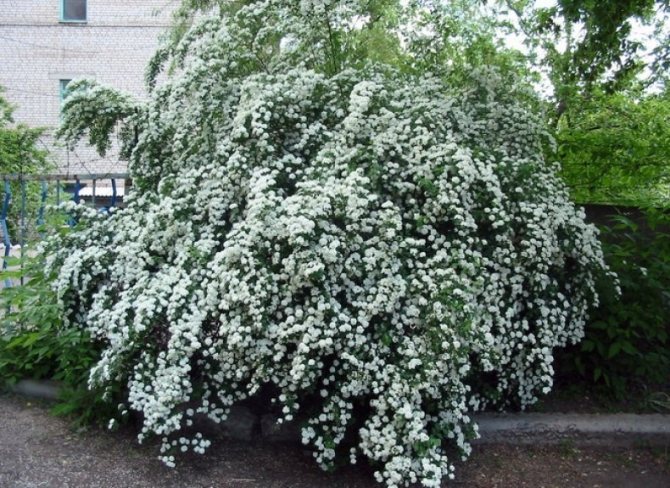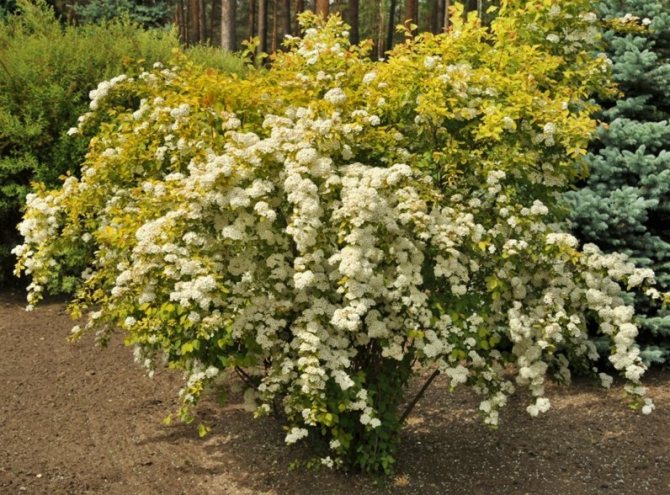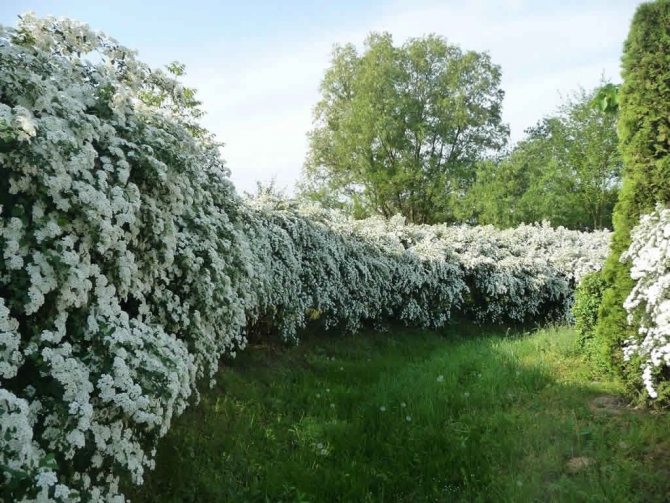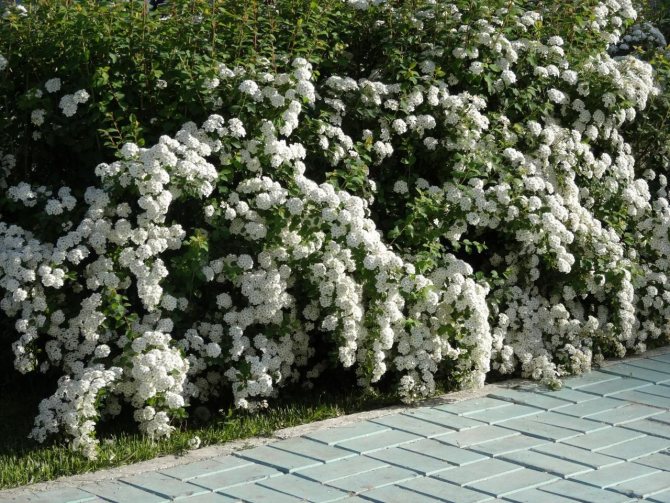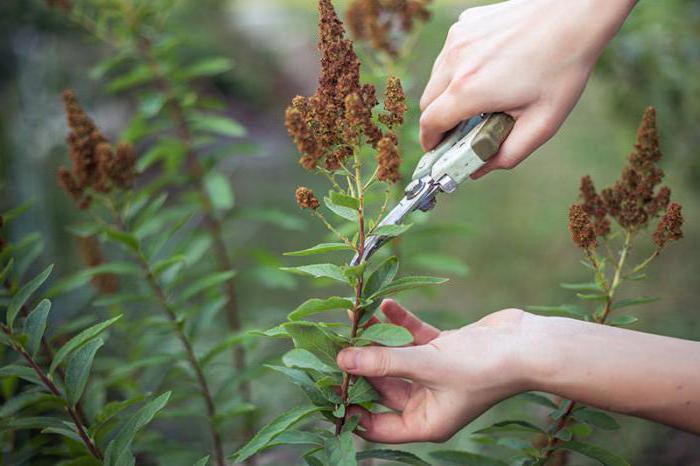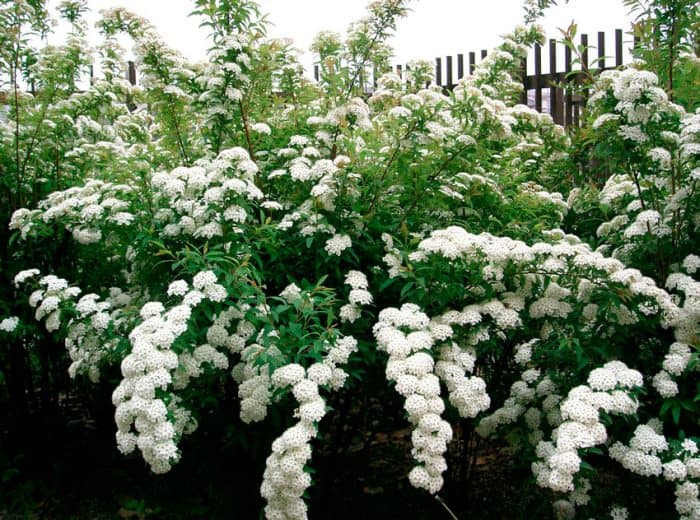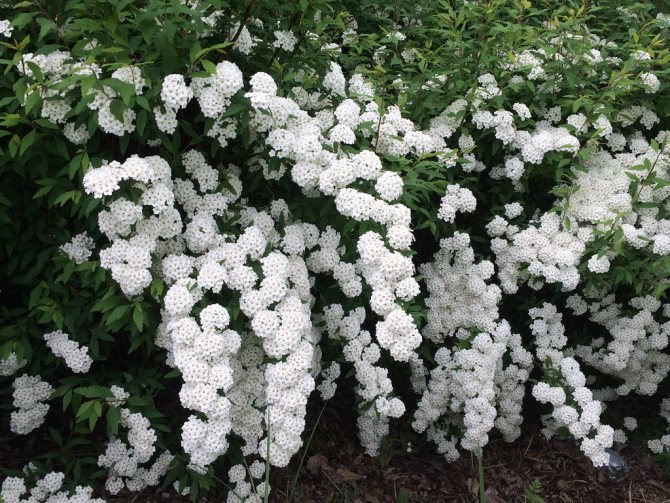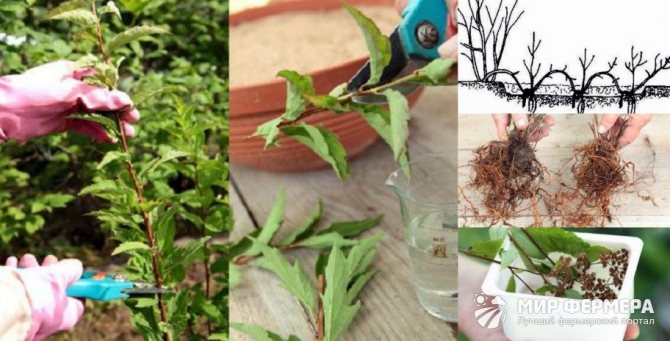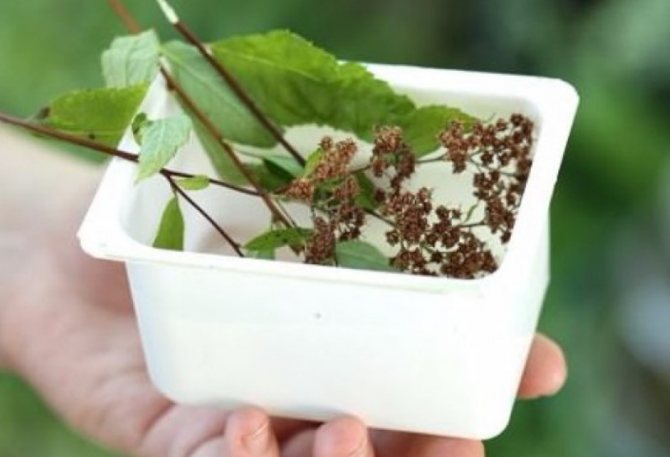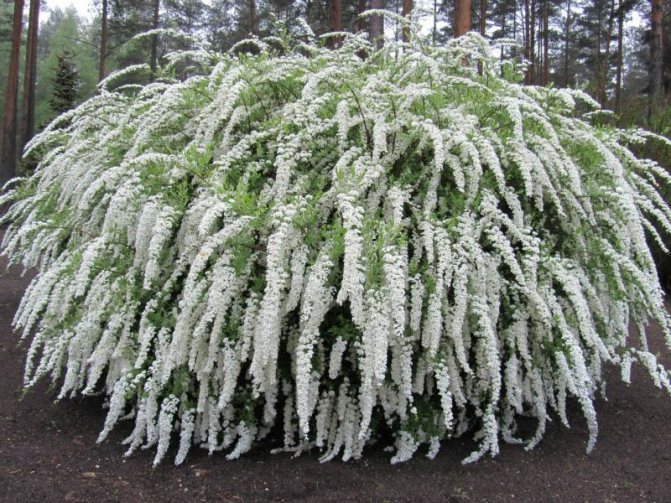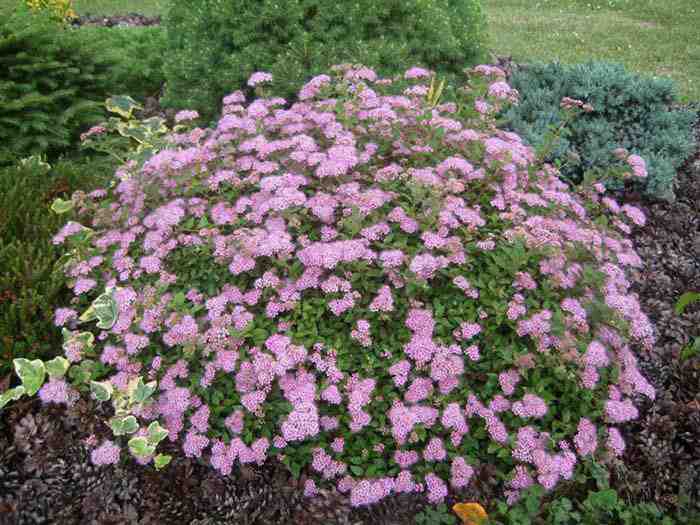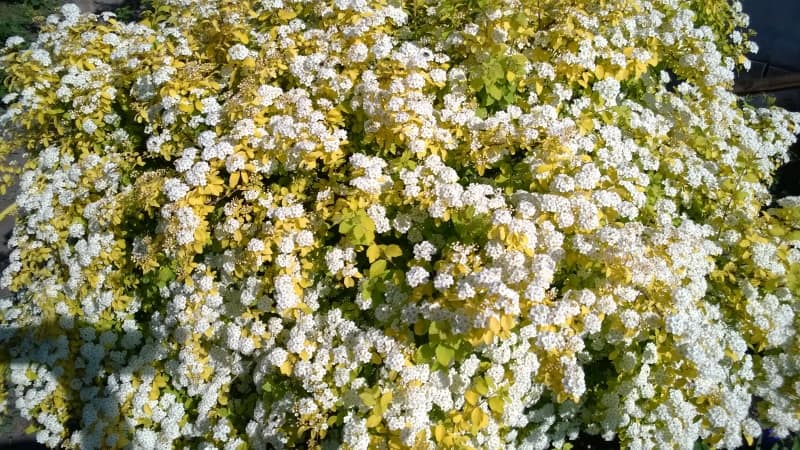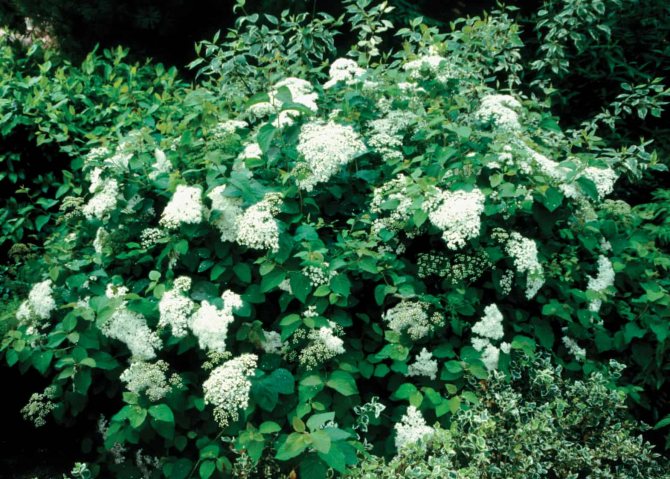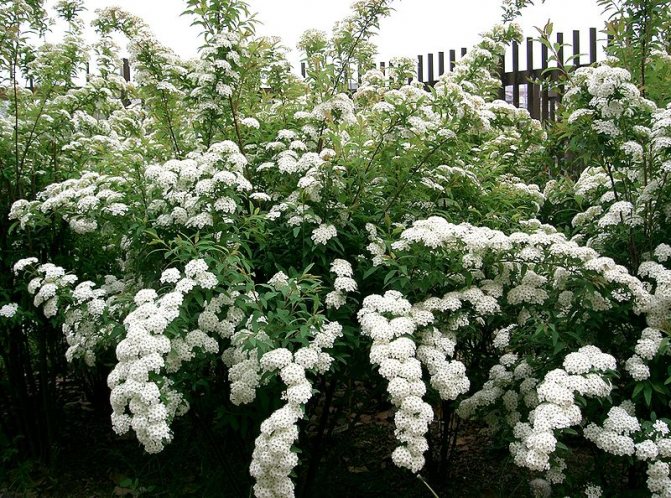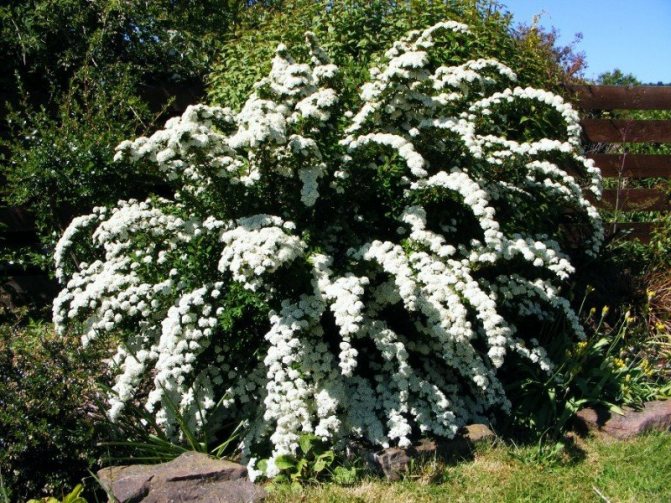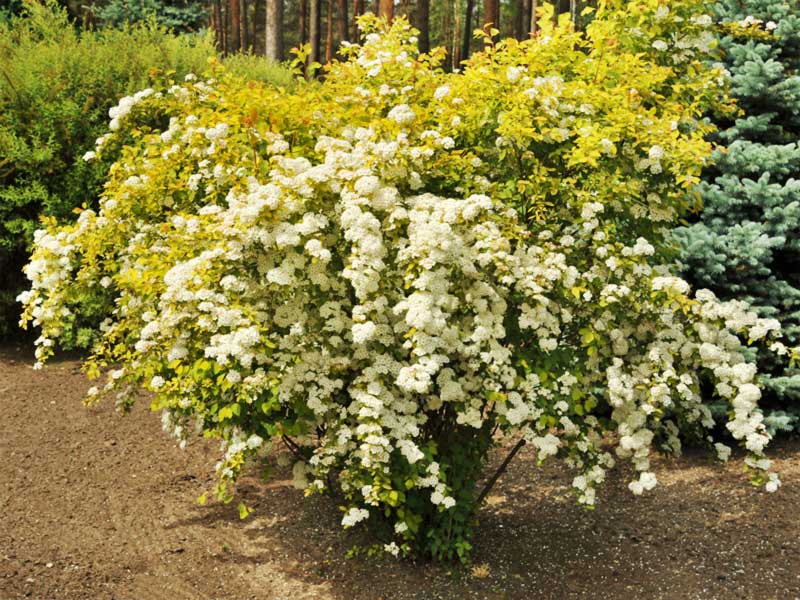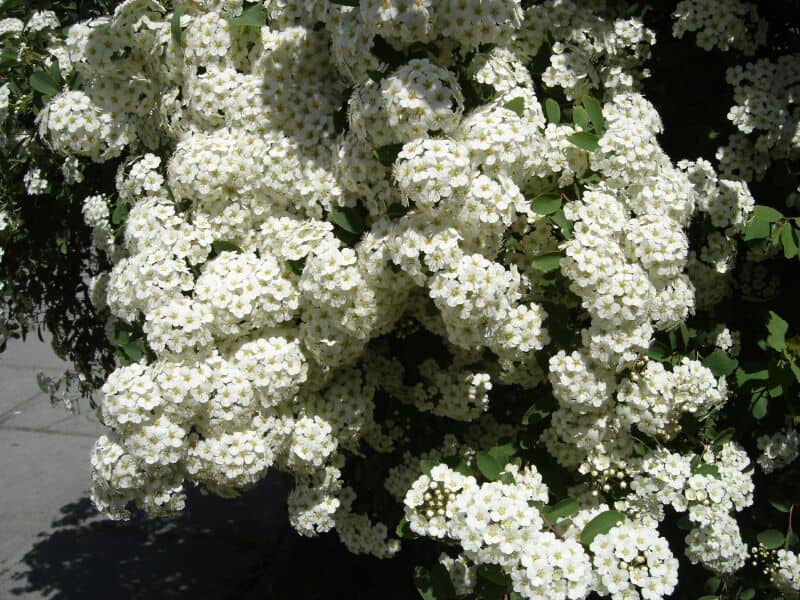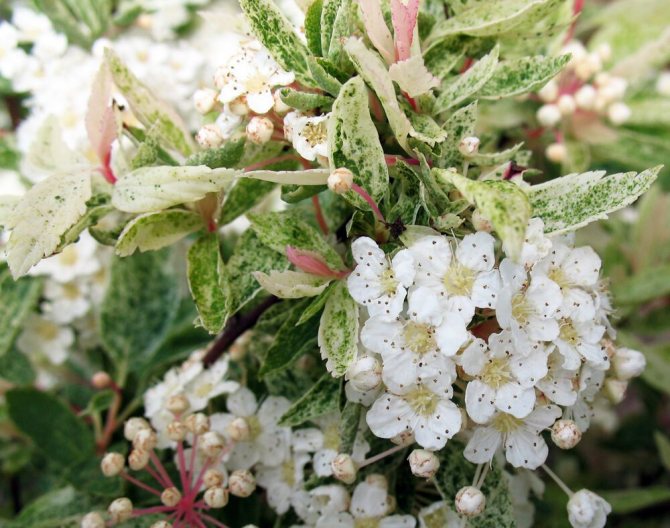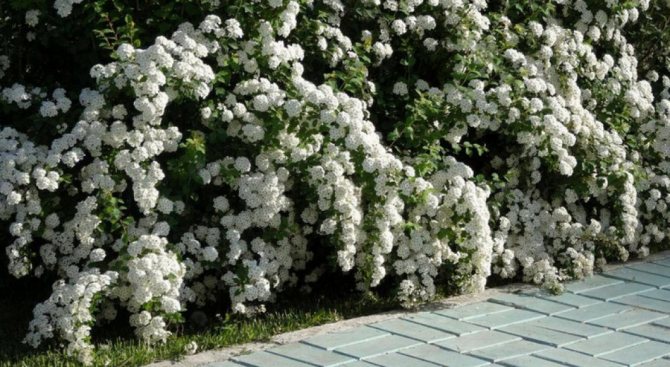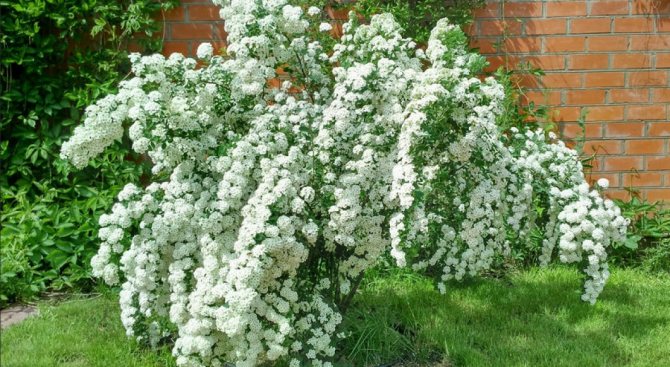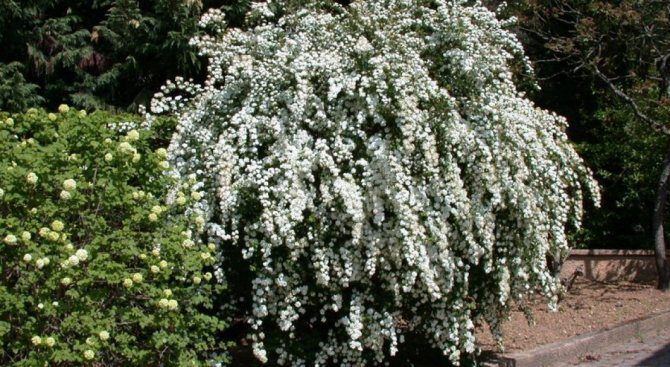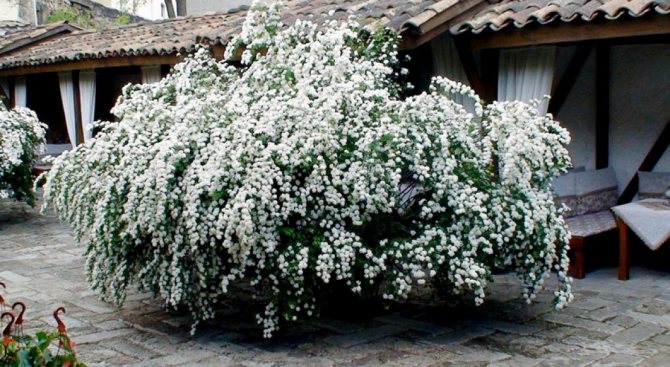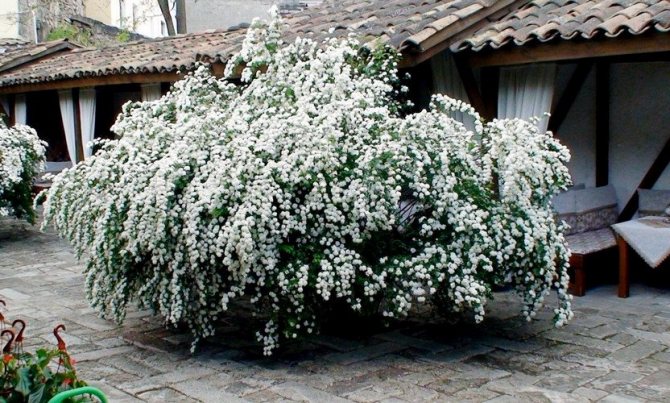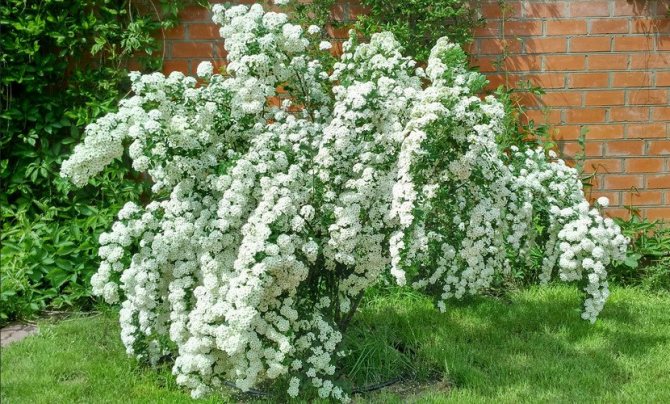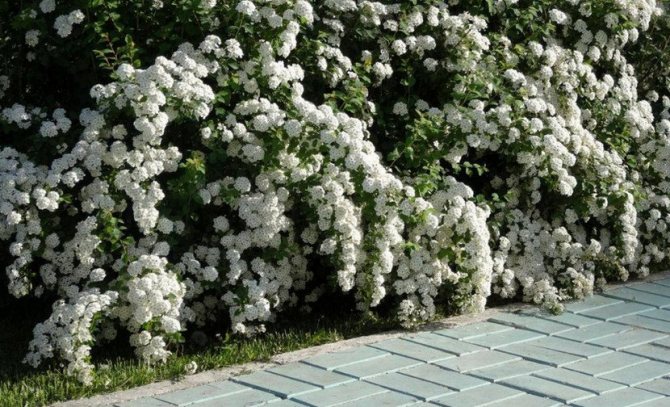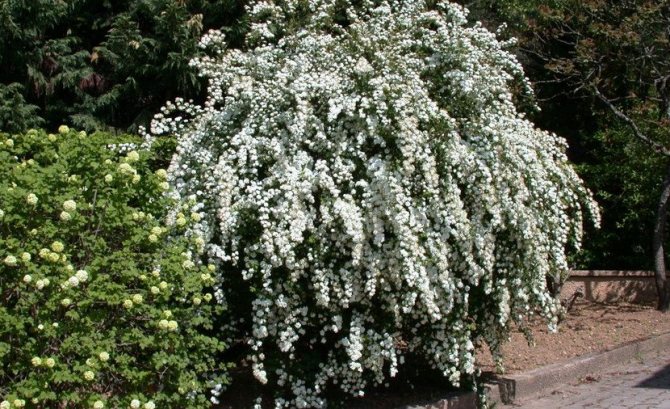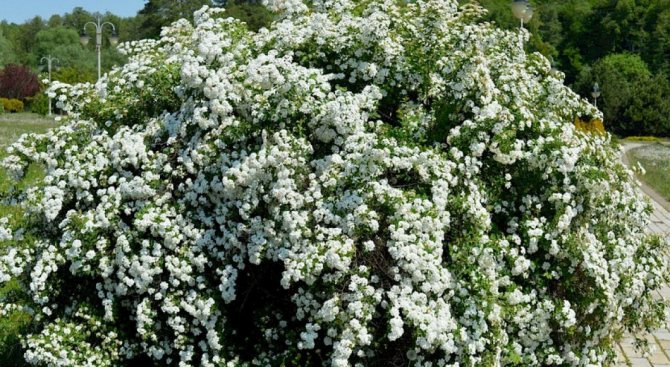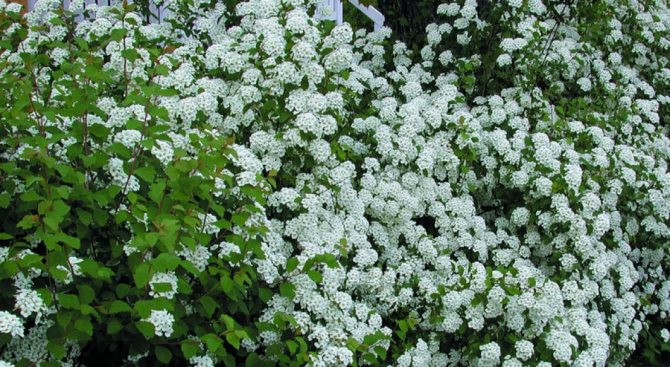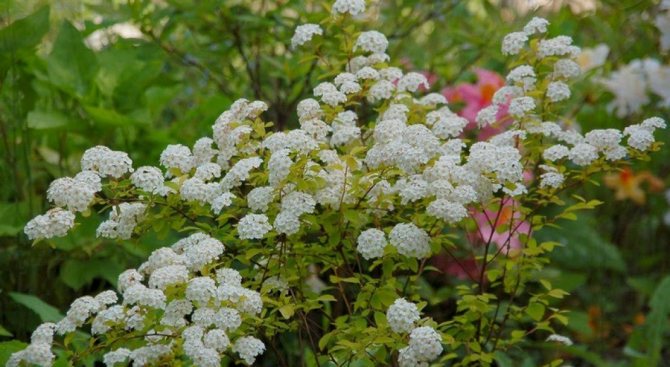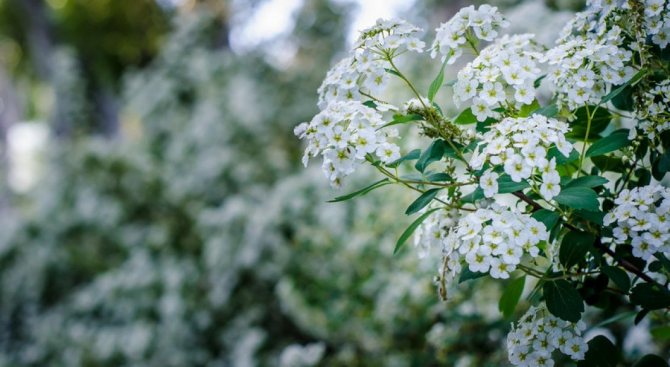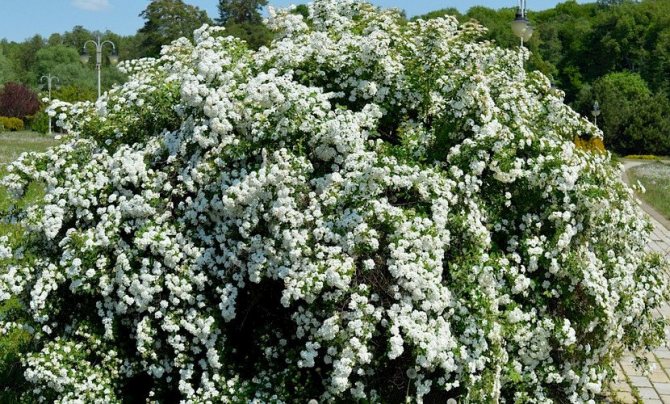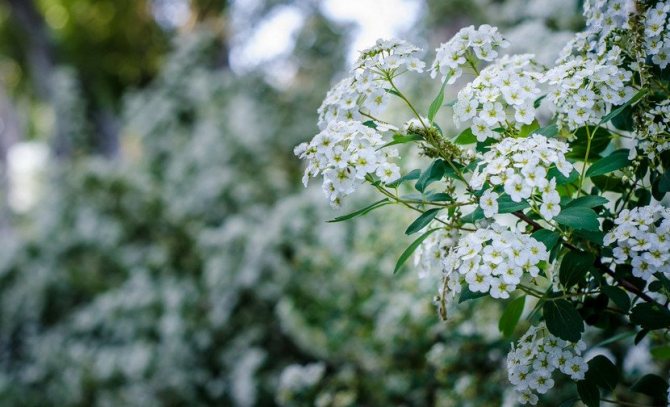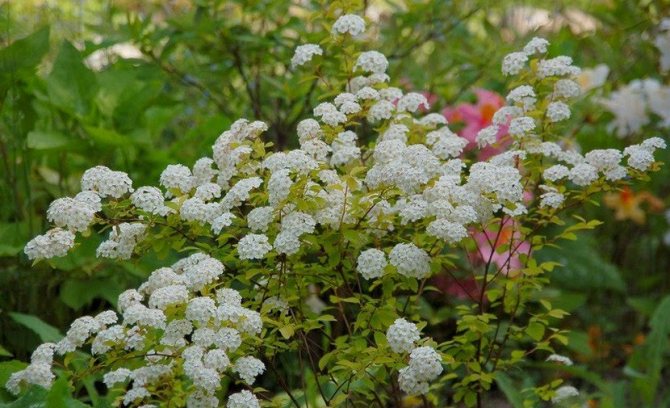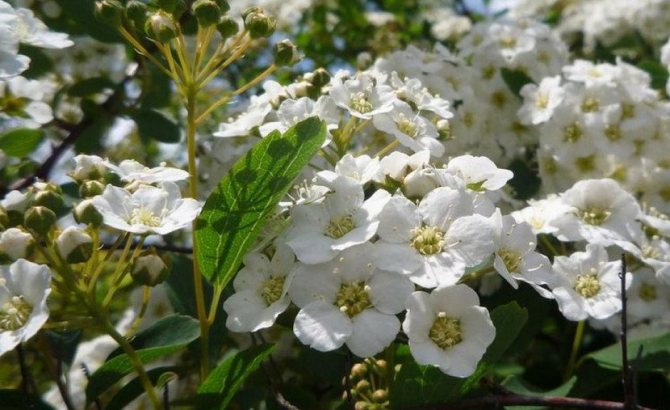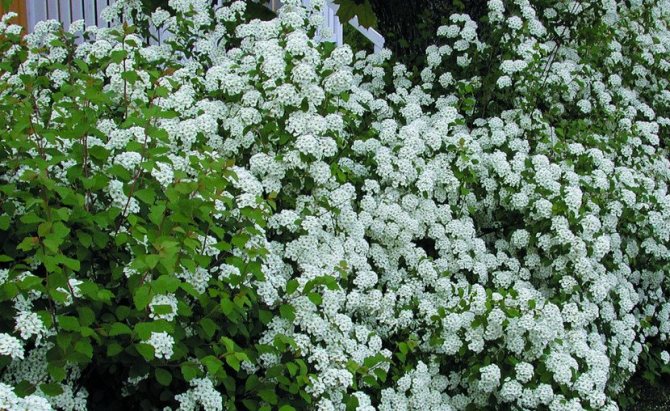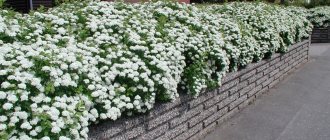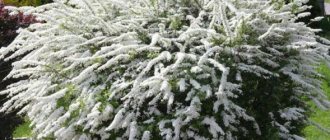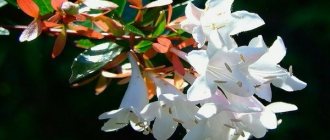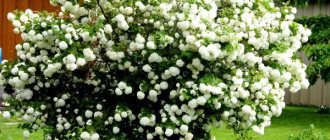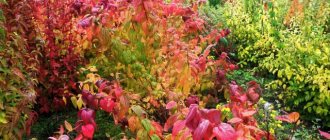A whole cascade of small white flowers cover the Wangutta spirea during flowering. The plant has small leaves - they are almost invisible under the abundantly flowering bunches. During flowering, the shrub emits a strong honey scent that attracts bees. This ornamental shrub is perfect for the Moscow region, because in cold winters the plant does not freeze out. In this article, you will learn all the subtleties and nuances of planting Wangutta spirea in the open field, as well as get acquainted with the main agrotechnical measures for the care of the crop.
Pruning, grafting and rooting spirea - a step-by-step master class with a photo
Adding an article to a new collection
The faded spirea does not look too decorative - a green bush with brown spots of dry brushes does not attract the eye. However, you should not forget about it, because after flowering, the best moment comes for grafting and rooting.
In the spring, such species bloom as Thunberg spiraea, gray spirea, crenate spirea, oak-leaved spirea, nippon spirea, alpine spirea, average spirea, Vangutta spirea, spiraea spiraea, St. John's-leaf spirea, sharp-serrated spiraea. They start blooming in April-May and finish by mid-July, depending on the region and weather. It is these species that are sheared after flowering, since they lay flower buds on the shoots of last year, actively grow and degenerate with a strong thickening of the bush.
If you have one of these shrubs, now is the time to tackle it. Not sure where to start? Watch your hands!
How to rejuvenate a shrub?
Mature specimens over 15 years old require anti-aging pruning. The event is carried out in the fall by completely removing the aerial part of the bush at the level of the root collar. The same scheme applies to a plant that has been severely damaged by pests. After such a cardinal intervention, summer-flowering varieties will bloom in the next season, and spring ones only a year later.
Advice
Do not leave stumps after clipping. Young thin and weak twigs will grow from dormant buds on pruning in spring.
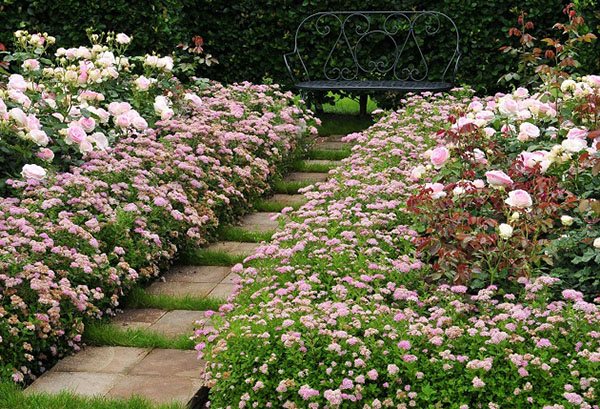
Spirea wangutta, planting and care
Probably the most beautiful and decorative of all shrubs is the spirea. It blooms profusely, while emitting a strong honey aroma, has gracefully curved long thin branches that are practically invisible under the bunches of flowers. The name spirea (spiraea) comes from the Greek word speira, which means bend. The popular name for the shrub is meadowsweet.
- Spirea wangutta, description
- Spirea wangutta, landing
- Spirea wangutta, pruning
- Reproduction of spirea wangutta
- Spirea wangutta, care
- Pest control
- Spirea wangutta, photo
Spirea care is a guarantee of exuberant flowering
In order for the Wangutta spirea bushes to bloom exuberantly every year, it is necessary to provide the plants with proper care, which boils down to uniform watering during the summer season and crown formation. All dried and damaged spirea branches must be periodically removed from the bush. After pruning, the plant bushes well, quickly grows the crown, it is only important to prune before the onset of cold weather.
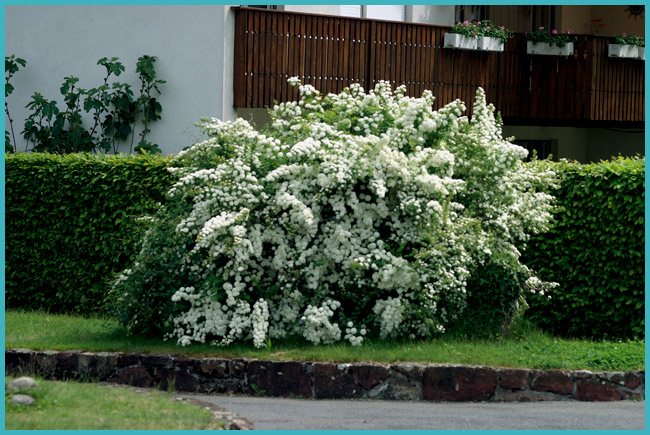

To give the shrub the desired shape and update it - prune
It is imperative to mulch the spirea plantings.Of great importance is the timely removal of pests from the spirea bushes, as well as the treatment of diseases.
Spirea wangutta, description
There are about 90 varieties of spirea. They are unpretentious, bloom profusely and for a long time. The shrub is about two meters high and has a wide variety of shapes: weeping, pyramidal, creeping, hemispherical, cascading, erect. Spirea usually has two flowering periods. One group blooms in the spring on last year's shoots and usually has white flowers. The second group blooms in summer on new shoots, its flowers are brightly colored. The leaves of the plant are serrated, the top is dark green, the bottom is bluish.
In autumn, spirea is no less decorative than in summer. After green, it turns orange, purple-red or yellow, and decorative fruits appear on its branches. This bright and showy shrub can be planted as a hedge, as a standing bush, or used to create flower bed compositions. Throughout the summer season, it will delight the eye with its beauty.
Hedge modeling
A spirea hedge is an excellent solution for a garden plot. It will protect your property from dust and exhaust gases, serve as a decoration and screen from prying eyes, without causing heavy shading.
After the autumn adjustment of the hedge shape, be sure to add potassium-phosphorus fertilizing and mulch the soil. Such a measure stimulates the healing of wounds, will help spirea in preparation for winter.
Systematic hedge trimming allows you to:
- achieve density by stimulating branching of shoots;
- to give the plant fence a compactness, a certain silhouette, height and shape;
- maintain the health of the hedge by improving ventilation and illumination of the bushes.
Modeling hedges is started a year after planting. Young bushes are pruned, removing a third of the annual growth. After 2-3 years, you can cut up to half of each twig to maintain the shape of the green fence. As you age, periodically trim the shrinking branches inside the crown.
Important!
Low pruning of the old fence will lead to the risk of drying out or freezing, since old bushes have an increased tendency to bare the root collar.
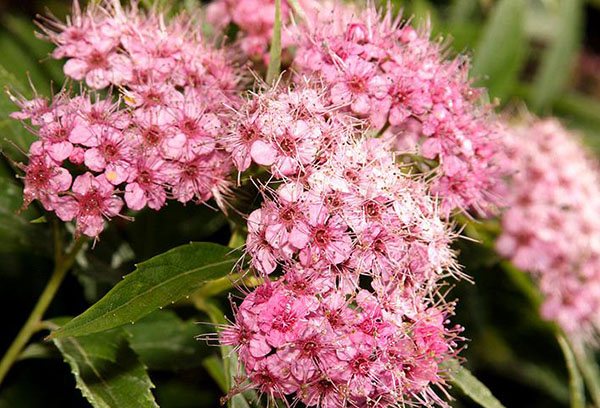

Spirea wangutta, landing
The planting time of the spirea depends on the time of its flowering. Cultivars that bloom in spring are best planted in the fall, after the leaves have completely fallen off. Varieties that bloom in summer or fall should be planted in spring. For spirea wangutta, planting in the spring should be done before the leaves bloom. The branches of the seedlings should be shortened with a secateurs by about one third. Long roots should also be shortened and damaged or rotten roots trimmed in an even cut.
You need to dig a spacious hole for planting so that the root system is located in it easily and does not rest against the edges and bottom. At the bottom of the planting pit, turf, sand and peat must be poured in equal proportions. Mix everything well, place the seedling so that its root collar is just below the soil level. After trampling, the earth will be crushed, and the root collar will be at the level of the soil. Make a small hole for watering and water liberally with spirea.
It is best to plant a shrub on the sunny side of the plots, but partial shade is also suitable. If the spirea does not receive enough light, then it will not bloom too abundantly. To create a hedge, the distance between the bushes in the rows should be about half a meter, and between the rows 30-40 cm. If you plant a spirea in a group, then there should be a distance of 0.5-0.7 meters between the seedlings.
Pruning spirea blooming in summer
Summer flowering shrub varieties respond well to pruning. The more shoots are removed, the more intensively the green mass grows.Haircuts are carried out every autumn, starting from the age of 3-4 years. Be sure to cut out any weak growth at the level of the root collar. In autumn or early spring, cut off the branches, leaving 2-3 developed buds above the lignified part.
Stimulating pruning consists in the complete removal of vegetation at a height of 30 cm. The event is carried out in early spring to stimulate tillering. Spirea, which is cared for according to all the rules, will recover very quickly and will delight you with abundant flowering already in the current season.
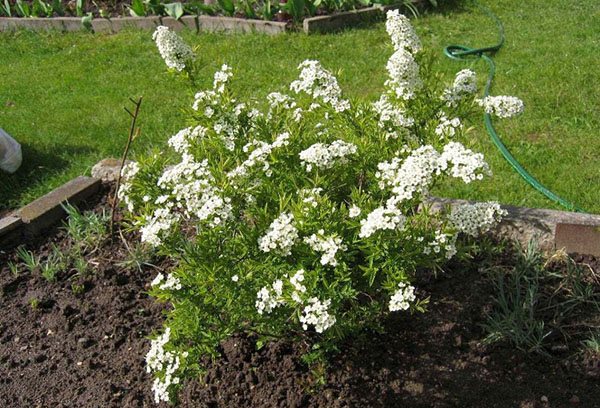

Spirea wangutta, pruning
A few years after planting, the spirea must be cut off in order to rejuvenate the bushes and give them the desired shape. It is necessary to prune when the branches become exposed, their partial drying out and the spirea flowers become smaller. This procedure must be performed depending on the flowering period of the bush. Pruning can be done on a tree stump, or only dry, damaged or old branches can be cut. In any case, the appearance of a blooming spirea will become much more attractive, and the inflorescences will be larger and brighter.
How to properly trim spirea
They work with the bushes as soon as the snow melts. Carrying out sanitary pruning of any meadowsweet bushes, they get rid of damaged shoots and weak growth inside the bush. The plant gives strength to healthy branches by increasing the number of buds. Remove all last year's dry inflorescences from summer flowering bushes. And for early flowering spirea, the care includes pruning of weak branches and old, 7-10-year-old shoots in March-April. The frozen tops are also cut off. When shortening the shoot, make sure that the cut falls over the bud, which grows outward.
Stimulating treatment means shortening branches so that they can grow. The shrub becomes lush and more decorative with many inflorescences.
Young shoots of meadowsweet, which blooms in summer, are shortened over well-developed buds, from which branches with buds grow in the spring. The same procedure for spring flowering species is performed in June. Bushes with old shoots transform, leaving only 25-30 cm of the trunk above the ground. The plant will renew itself more lush.
Formative pruning of spirea bushes is also carried out in spring or summer. Cutting off parts of the shoots for the growth of new branches, they try to make the cutting lines at the same level, gradually rounding the silhouette of the bush. The formation of a hedge from meadowsweet bushes, which blooms in July, is postponed until the end of August, in the spring it remains only to trim the lines. At the same time, the shrub is thinned out inside, removing old and twisted branches. Thickening can provoke the development of fungal diseases or create a cozy environment for pests. The thickening of the meadowsweet bush is controlled every 2-3 years. For the formation and pruning of early flowering spirea, the frozen branches are removed, and dense thickets are thinned out. To improve tillering, the longest shoots are shortened by 20-25 cm.
Achieve rejuvenation of the shrub by completely trimming the trunks to the level of the root collar. Sometimes only 5-7 last year's branches are left. Such measures are taken for old plants, after 10-12 years of development. Thanks to such pruning, spireas, whose trunks live 15-19 years, will develop for a long time in the place chosen by the gardener.
Reproduction of spirea wangutta
There are several ways to propagate spirea - by dividing the bush, cuttings, layering and seeds.
This is the easiest way, in which in the spring the lower semi-lignified branch of the bush must be bent to the ground, placed in a pre-dug depression and covered with earth. You can put a small stone on top or fix it with a wire pin. For the winter, it is necessary to cover the shoot with dry leaves. In the spring, the rooted shoot can be transplanted to a permanent place.
- Reproduction by dividing the bush.
This method is described above in the "Spirea planting" section.
In the first half of June (early flowering varieties) or in July (late flowering varieties) cuttings are harvested and rooted in a substrate of river sand and peat in a 1: 1 ratio. To get good cuttings, you need frequent (several times a day) watering. Cuttings are planted in a permanent place in the spring.
All types of spirea can be propagated by seeds. The seeds formed at the bush must be sown in spring in boxes filled with a well-moistened mixture of peat and leafy soil. In about 10 days, friendly shoots will appear. The picking of seedlings should be done only after 2-3 months. To do this, the seedlings need to be removed from the ground, slightly shortened the roots and transplanted to the garden bed. Seedlings need standard care - watering, loosening, mulching.
Preparing spirea for winter
Autumn care for spirea necessarily includes preparation for a dormant period. Youngsters are wrapped up for the winter to avoid freezing. For this, the twigs are loosely pulled together with twine and wrapped with covering material. In harsh climates, it is better to build an air-dry shelter.
The root system of the spirea lies close to the surface of the soil, so it is better to insulate even adult bushes. Cover the root collar with a layer of leaf or peat mulch 10-15 cm thick.
With proper care, including systematic pruning and rejuvenation, the ornamental spirea shrub will adorn the garden for 20-25 years. Since spring work takes up a lot of gardeners' time, it is convenient to postpone the care of lush bushes until autumn.
Pest control
The main pests of wangutta spirea are aphids, multi-colored miner and rose leafworm. But the biggest danger to spirea is the spider mite. In May, the females of the tick settle on the underside of the leaf and weave their webs there. In the season, about ten generations of ticks appear, which infect the leaves of the bush. They begin to yellow early, dry and fall off. For the destruction of spirea pests, various control methods can be used: chemical, biological and agrotechnical. If you carefully care for the bushes, make timely watering, top dressing, spray in dry hot weather, then these actions will give a positive result.
Spirea wangutta is perfectly combined with other plants on the site and will easily fit into any garden composition. The shrub blooms at different times, therefore, if you skillfully select the types of spirea, then you can create a garden of continuous flowering, where the spirea wangutta white will be replaced by pink, and then crimson. And different parts of the garden will enchant their visitors with the beauty of blooming spire.
Care after pruning
After removing branches or parts of shoots, meadowsweet are abundantly watered and fed during mulching using peat or compost. After summer pruning, the shrub is maintained with a mixture of organics and minerals. Mullein is cooked in a 1: 5 ratio. 10 g of superphosphate, already diluted in a liter of hot water and infused throughout the day, is mixed into the bucket with mullein infusion. 10 liters of liquid dressing are poured under 1 bush. The day before fertilization, the bush is watered so that the nutrients get into the damp soil and are absorbed faster by the roots. Some time after applying top dressing, the trunk circle is spilled with another bucket of water if the soil is not sufficiently moistened. Sawdust or compost foliage can be used as mulch.
What is attractive about this particular species?
First of all, its attractiveness is aesthetic. The shrub, reaching a height of up to two meters, has flexible spreading branches, which are not visible during the flowering period: the inflorescences are so densely and densely located.
Shrub varieties have a variety of shapes:
- pyramidal;
- weeping;
- upright;
- creeping;
- hemispherical;
- cascade.
The most common shape is spherical.This comparison is achieved due to the fact that branches-twigs hang down to the ground from all sides of the trunk, forming a vegetable ball.
The leaves of the plant during the flowering period are usually green, although unusual foliage colors are also found: for example, the Vangutta Gold Fontaine spirea has yellow-green leaves.
Varieties of spirea
The genus Spiraea belongs to the Pink family, and includes over 80 species of ornamental deciduous shrubs. The average height of the culture is 90–170 cm, the crown circumference reaches 2.5 m. The openwork crown is made up of thin shoots, sagging under a mass of inflorescences almost to the ground. Therefore, spirea is often compared to a snow-white fountain. The first flowering occurs in the 3-4th year of the growing season, limited by the appearance of individual inflorescences. In subsequent years, the shrub tirelessly pleases gardeners with splendor. The plant can act as a spectacular soloist or join a group. Due to their endurance, unpretentiousness, resistance to dust, spireas are often used as hedges.
If you choose the right cultivars in terms of flowering time, you can achieve the continuity of this process for 3-3.5 months.
The timing and features of pruning a shrub directly depend on its variety. All types of spirea are usually subdivided by flowering time into spring-flowering and summer-flowering ones. Let's consider the main representatives of these groups.
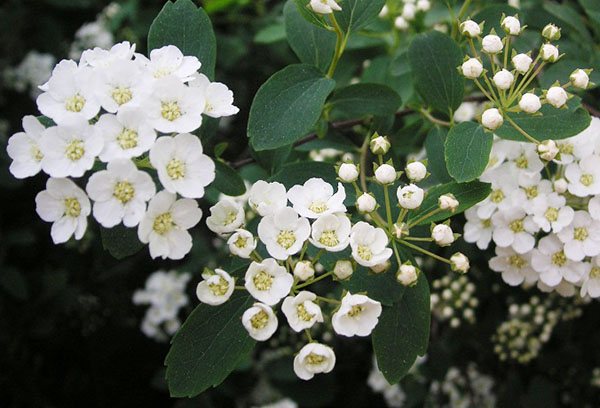

Early flowering (spring) species of meadowsweet
Snow-white flowers with a yellow core and incredibly long stamens are a feature inherent in early flowering spireas. Dense inflorescences of corymbose or umbellate form densely stick around thin shoots, forcing them to bend to the ground. The appearance of "snow" on the branches occurs in late spring or early summer. Flower buds are laid on the shoots of the last year, located along the entire length of the branches. May "snow storm" lasts only 2-3 weeks, fills the garden with fragrance, attracting a lot of pollinators.
The following spring types of spirea are most often found in culture:
- Wangutta;
- Nippon;
- Thunberg;
- Oak-leaved;
- Gray;
- Arguta;
- Average;
- Gorodchaty.
They differ slightly in height, shape of crown and leaves, size of flowers, inflorescences. Some representatives have a snow-white color, others have a cream color. The Nippon Spirea dresses up in a crimson dress in the fall, and Wangutta burns with an orange flame.
The listed varieties are photophilous, but tolerate light shading. Spireas are capable of growing in Spartan conditions, but without proper pruning and periodic rejuvenation, they first grow and look sloppy, and then begin to wither away, lose their decorative effect.
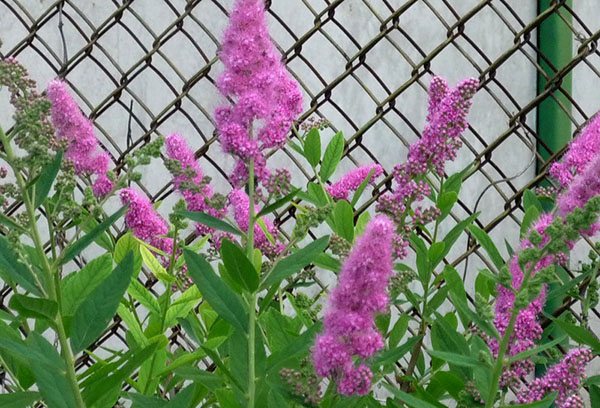

Summer blooming spireas
Representatives of this group bloom throughout the summer. They are characterized by bright juicy colors of inflorescences - pink, reddish, purple. Inflorescences are formed on the growths of the current year, have the form of panicles or large scutes.
Summer-flowering spireas include the following types:
Like their spring sisters, summer-flowering spireas are unpretentious, light-loving, and can steadily tolerate gas pollution. The listed cultures will perfectly fit into the design of any garden, decorate a rabatka, mixborder. Especially gardeners are attracted by Japanese spirea, on the basis of which a lot of beautiful varieties and decorative variegated forms are obtained. Cultivars of the Japanese meadowsweet are easy to shape and are used to create garden sculptures.
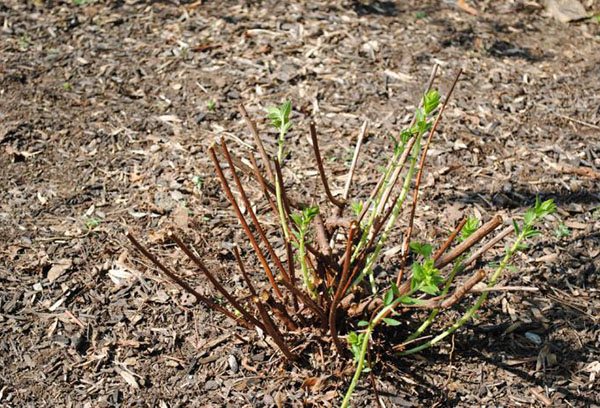

Landscape designers choose Wangutta
Experts know how a selection variety can look spectacular on a plot:
- Decorative fence. Spirea Wangutta, used as a hedge, will protect the garden or summer cottage from the street and at the same time become its decoration;
- On the shore of an artificial reservoir, the plant is used as a substitute for willow.
- On a lawn or flower bed, a lonely growing spirea bush of this species looks great.
Both professionals and amateur gardeners are convinced: any variety of Vangutta spirea will "fit" a wide variety of areas and will delight their owners.
Landscape design: spirea is indispensable for creating park compositions
Photos of park compositions of the world's best gardens prove that Wangutta's spirea is used for planting in parks by landscape architects from different countries. The high decorative qualities of the shrub, its spherical shape, amazing white flowers, allow the plant to be used to create complex compositions and in specimen plantings.
Spirey bushes of spirea are appropriate for planting on a green lawn, along paths, near pools and fountains. The plant easily decorates low fences, dilapidated walls of buildings and outbuildings.
Spirea Wangutta is ideal for architectural compositions with the inclusion of small decorative forms of park equipment (benches, swings, playgrounds).
Growing spirea Wangutta: video
Spirea: photo
We start spirea Wangutta
It is not difficult to get a beautiful ornamental shrub even for a gardener with little experience, if planting and care is carried out taking into account the advice of experts.
The best place for the Wangutta spirea is a well-lit slope or hill with light soil, without stagnation of groundwater.
Landing
In the Vangutta spirea, the planting corresponds to the flowering period of a particular variety:
- in the fall, after the leaves have completely fallen off, varieties that bloom in the spring are planted;
- in the spring, varieties are planted, the flowering of which occurs in summer-autumn.
At any time of the year, only a leafless plant is transplanted, before the foliage blooms or after it falls.
Important: when planting, you should prepare a seedling: shorten the twigs by a third, trim the roots, remove the areas affected by the fungal disease.
Gorgeous spirea bush
The finished seedling must comply with the proportions of the volume of the root system and the ground part. If necessary, the overgrown root system is thinned out, if the rhizome is weak - to maintain the proportion - cut off the excess branches. If the seedling has a closed root system, it is advisable to soak the roots for several hours in water before planting or spill a clod of earth abundantly.
Planting stages
- Prepare a spacious planting pit (the volume of the pit should exceed the volume of the seedling rhizomes by 20-25%);
- Single landings: pit depth and diameter - from 50 cm;
- Group planting: the distance between seedlings is from 0.7 to 1.5 m;
- Hedge: seedlings are placed at a distance of 0.5 m from each other.
Fill the hole with drainage mixture (7-20 cm) before planting. To do this, combine sand, gravel and pebbles, as well as mixed earth, sand, peat in equal parts.
- Plant the seedling by placing the root collar slightly lower than the soil level.
- Compact the hole, trampling it down so that the soil level is even with the root collar.
- Water the plant abundantly.
Pruning
Bush hedge
To rejuvenate and shape the bush, plant pruning is systematically used.
Important: pruning is done at least 2 years after planting the shrub.
The shrub itself suggests that it needs pruning: the branches become bare and partially dry out, the flowers become small.
The timing of pruning of different varieties correlates with the timing of flowering.
- pruning on a stump;
- cutting of individual branches. This removes dry, diseased, old branches.
Reproduction
You can plant the Wangutta spirea using several methods:
- layering. Reproduction is carried out in the spring, by dropping a branch at the bottom of the plant. The next spring, the shoot that has overwintered under dry foliage can be transplanted;
- by cuttings. Harvesting of cuttings begins in the summer, after rooting, abundant watering is required (several times a day). Cuttings are planted in spring;
- seeds. Seeds are sown in the spring in flower containers or greenhouses. Seedlings appear after 10 days. You can start picking seedlings in 2-3 months.
Important: seed propagation is rarely used. This is due to the poor germination of Wangutta spirea seeds. If you decide to use this method, use only fresh seeds.
The shrub responds well to mulching after planting
Care
A beautiful plant attracts gardeners with undemanding special care.
Bush
- grows in any soil;
- frost-resistant and drought-resistant;
- needs feeding only on poor soils;
- requires even watering as the soil dries up.
Important: if the seedlings were planted in the fall, they must be covered for the winter, despite the frost resistance of an adult plant.
The shrub responds well to mulching after planting. For this, peat is used. The optimum mulching depth is 7 cm.
Top dressing
Spirea Wangutta does not require special feeding. It is produced no more than once a season (usually in spring) with a complex mineral fertilizer. For a better effect, rotted manure is added to a warm solution of mineral fertilizer.
For better flowering, you can use double superphosphate, which is laid in the soil, making it more nutritious.
Pruning after planting, transplanting, dividing the bush
Planting and transplanting of ornamental shrubs is carried out in the fall. At the same time, it is customary to divide the bushes 3-4 years old to get new specimens. To facilitate the adaptation of the bush to a new place, planting work is combined with pruning.
Work is carried out in early autumn, as soon as a change in the color of the foliage is outlined. Choose a cloudy or rainy day and stick to the following algorithm.
- Remove the bush from the soil, after digging it around the perimeter of half of the crown projection.
- Thoroughly rinse the roots, divide into several parts so that the division has renewal buds, shoots and a developed root network.
- In advance (3-4 days) equip the planting hole with a diameter and depth of 40-50 cm.
- Fill the hole with broken brick or rubble drainage to a height of 15 cm.
- Prepare a substrate of peat, leafy soil and coarse sand (1: 2: 1), fill a third of the hole with it.
- Place the cut, seedling or transplanted plant in the hole, top up the soil so that the root collar is level with the ground.
- Compact the substrate a little, water and mulch with peat chips.
- Remove any weak and damaged branches.
- Shorten skeletal shoots to the level of mature wood.
- If the bush has old shoots, remove them immediately, since in the spring they will die anyway and attract pests.
The distance between the bushes for a solo planting should be at least 1.5 m, for a group planting - 70-80 cm. If you plan to plant a hedge, reduce the step between specimens to half a meter.
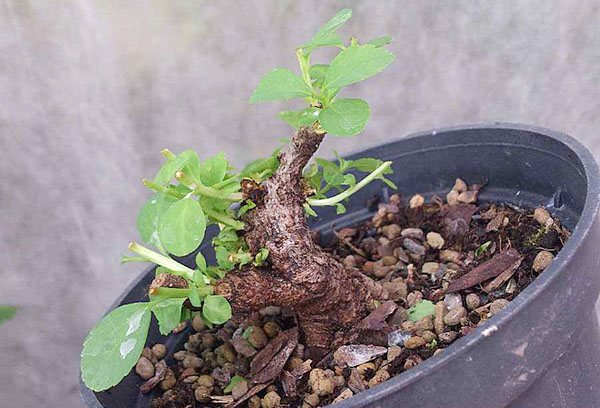

Diseases, pests and control of them
In addition to aesthetic pleasure, a kind of shrub has useful properties
The main harm to Vangutta spirea is caused by spider mites, aphids, pink leafworm, multi-colored miner.
To combat them, traditional methods known to gardeners are used:
- biological;
- chemical (with special drugs);
- agrotechnical (weeding, timely watering and water spraying).
In some cases, an outbreak of fungal infection is observed on the plants. The reason for its spread is waterlogging of the soil. For treatment, fungicides are used, as well as water regulation.
Types and terms of pruning shrubs
Throughout the growing season, meadowsweet should be periodically pruned. This plant is so plastic that it is easy to form, and reacts very positively to pruning, throwing out more powerful shoots and forming a larger number of inflorescences. Thanks to the haircut, it is possible to achieve an increase in the decorativeness of the culture, because the meadowsweet belongs to the fast-growing species. It gives a lot of root growth and shoots, so without timely cutting it will become a messy bush.
Depending on the goals pursued, spirea pruning is divided into the following types:
- sanitizing;
- stimulating;
- formative;
- anti-aging.
The shoots of meadowsweet are short-lived and after 1-2 years they begin to dry out. If left on the bush, the twigs will become a haven for pests, a breeding ground for fungal spores. Some types of shrubs do not tolerate frosts very well, the tips of the branches freeze slightly. To protect the culture from diseases and restore decorativeness, throughout the growing season, gardeners remove diseased, dry, broken branches. Frozen shoots are cut in the spring before bud break.
Stimulating haircut is used for early flowering meadowsweet over 3-4 years old. By removing weak growth, branching is stimulated, flowering is enhanced. This approach will improve the illumination and ventilation of the crown, which will have a beneficial effect on the health of the culture. A stimulating haircut is carried out in early autumn.
It is customary to deal with the formation of a shrub in spring or autumn. The autumn period for gardeners is less loaded with work, therefore, more often the crown of the spirea is formed in the fall.
A shaping haircut can be moderate or dramatic. In the first case, the silhouette of the bush is simply slightly corrected, in the second, so many branches are cut off so that the culture takes the desired shape.
Rejuvenating pruning will be needed for a plant over 15 years old. From this age, biological aging begins, the bush gradually loses its attractiveness. Autumn pruning is performed 2-3 weeks before frost so that the wounds have time to heal.
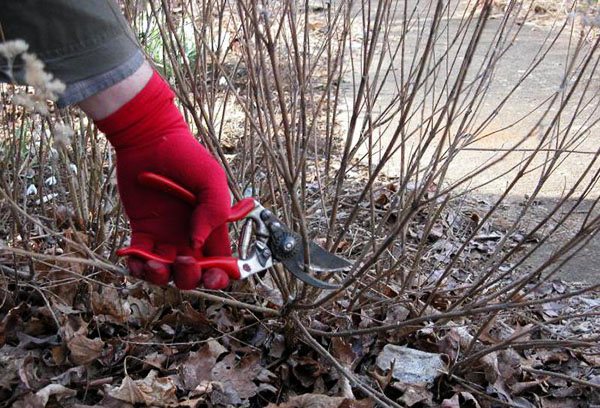

The benefits of a shrub
In addition to aesthetic pleasure, a kind of shrub has useful properties:
- melliferousness. During the flowering period, the shrub is a good honey plant, has a bright sweetish aroma that attracts bees. Placing hives in areas with Vangutta spirea is very effective;
- decorativeness. Spirea Wangutta is good at cutting, interesting when used in bouquets, flower arrangements;
- environmental friendliness. Due to its high phytoncidal activity, the shrub contributes to the improvement of the environment, has a beneficial effect on humans.
Undemanding spirea Wangutta is very responsive to care. Wonderful aroma and unique beauty are her gratitude.
Pruning early flowering spirits
Early flowering spireas are prone to growing a large number of shoots, therefore, they require the obligatory removal of part of the shoot. If the bush grows alone, gardeners recommend creating a strong skeleton by removing weak growth. In the fall, a quarter of the shoots are cut off at soil level. Over the next season, the bush will drive out new young twigs.
Early flowering species are sheared after the wilting of the inflorescences, in the middle of summer, but more often the event is postponed until autumn, when the crown is clearly visible. It is impossible to be zealous with a haircut, because the flower buds have already been laid, so gardeners cut off only a third of the annual growth. This stimulates tillering, enhances flowering. Unbranched branches, which are often observed in gray spirea Grefsheim and Wangutta (hybrids), are cut in half, and a third of the growth is cut off at each fork.
In the spring, pruning is not carried out so as not to lose some of the inflorescences. Only frozen tips and branches broken by snow are removed.
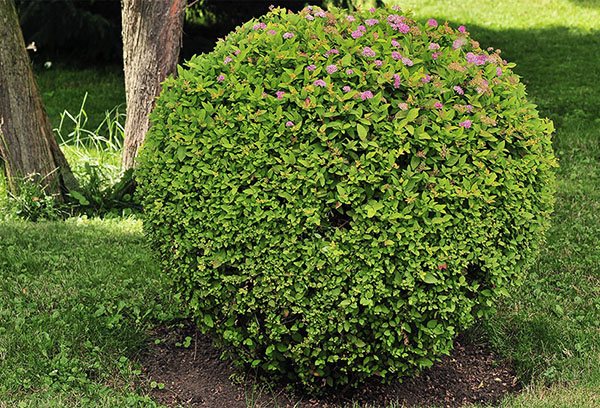

Reviews and comments
I like the spirea because it lends itself easily and tolerates a haircut without any problems, you can mold it as you wish, and it is very simple to care for the bush. I planted species that bloom at different times in turn, so I have a fence, smart from spring to late summer. In recent years, she began to notice that with aging, Japanese spirea bushes recover worse after low pruning, they have a tendency to bare the root collar.
Practically everywhere there are recommendations regarding the removal of inflorescences as they wilt.I do not do this, they do not spoil the appearance, so why not postpone the procedure for the main pruning season - autumn. I live in the Moscow region, I don’t cover the branches of the spirea with Gray, I only mulch the ground and add snow, my friends from Crimea don’t protect the shrubs at all, their thermophilic varieties overwinter without consequences.
I think that spring pruning of meadowsweet is necessary only for the purpose of preventing and improving the bush, I remove unwintered and dried branches, I leave the main haircut for the fall (in the Urals in the first half of September). The last time I feed the bushes no later than August, there was an unsuccessful experience, after pruning I applied fertilizers, young shoots went, frosts hit and shelter, of course, did not save them. The bush recovered quickly, but bloomed very badly. For the winter, I put arcs over the bent branches, cover it with polyethylene, and put a layer of spruce branches on top.
Spirea is a very beautiful-flowering shrub that is often grown on plots as a separate element of the landscape or in the form of group plantings (for hedges or curbs). The plant has gained particular popularity among flower growers not only due to its external beauty, but also to the lack of the need to create special conditions for its growth, in other words, spirea is a very unpretentious shrub.
However, even such an absolutely not capricious plant requires some care in the autumn. We will talk about this further.
Choosing a site for planting spirea
The spirea shrub "feels" well both in the sun and in the shade, but if you want to have abundant flowering of the spirea, it is better to plant the shrub in open areas where there is a lot of sunlight during the day.
Spirea is not picky about the type of soil. Will grow well on sandy soil, but moist and depleted rocky soil is fine for her too.
In order for flowers to appear in the second year of the life of the spirea bush, it is necessary to plant spirea seedlings in open ground in the fall, at the moment when the spirea bush throws off its leaves.
If your spirea seedlings have an open root system, then the soil can be mixed with compost and sand. If the ground is too waterlogged, then a drainage layer can be laid on the bottom of the pit. This will ensure the removal of excess moisture from the roots and prevent rotting and disease.
Application in landscape design
Landscape designers love the spectacular wangutta and include it in the creation of unusual compositions:
- hedge;
- single copies;
- decoration of lawns;
- ensemble with other plants.
The good survival rate of spirea in cities allows them to be planted near kindergartens, schools, various enterprises, in parks. Lush wangutta will be well complemented by rose bushes, plantings of peonies, lilies, asters. It is also combined with thuja, spruce, juniper. A spectacular haircut allows you to create strict compositions with spirea. Can replace willow near any body of water.
Spirea: varieties, types, classification by flowering time
The Vangutta Spirea variety was bred in France as a result of crossing the existing species - Cantonese Spirea and Three-bladed Spirea. The bush does not exceed 2 meters in height, it has a compact rounded shape. Spirea looks great in single and group plantings, suitable for framing paths, used in landscape design in complex compositions with different plants.
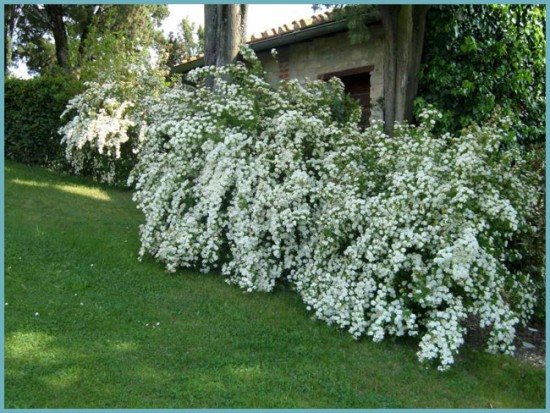

Spirea will perfectly fit into any garden composition
Spirea reaches its highest decorativeness during flowering. Umbrella-type inflorescences with white petals are distinguished by sophistication and sophistication. Looking at the photo of a blooming spirea, you feel airiness and lightness. A flowering spirea bush looks like a white cloud.
The genus of spirea is represented in culture by two species, which differ in terms of flowering:
- spring flowering;
- summer flowering.
Spirea Wangutta, according to the classification, belongs to the first group.For spring-flowering species (gray spirea, Vangutta, arguta, nippon), pure white flowers are characteristic, which bloom on the shoots of last year in the spring. The bushes of these plants are quite lush, have many branched trunks, spherical in shape.
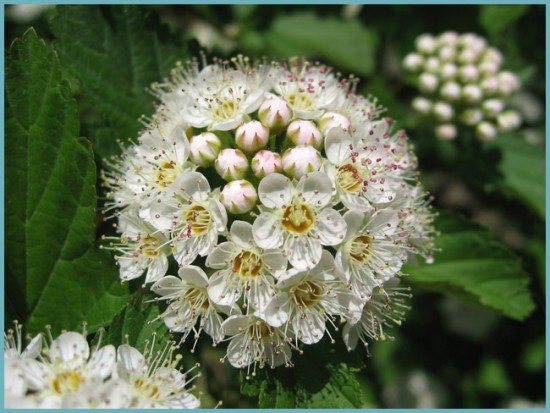

Spirea Wangutta - spring flowering species
Summer-flowering species of spirea (Japanese spirea, Bumolda, willow leaf) bloom on the shoots of the current year in the summer. Old shoots of spirea, on which flowering has ended, die off over time. The color of the petals of the summer flowering spiraea is much richer - there are pink, lilac or reddish petals.
Description and varieties
French breeders bred this species in the second half of the 19th century, crossing the Cantonese and three-bladed spirea. She immediately fell in love with gardeners, and since that time has not lost its popularity. Spirea Vangutta is a spherical shrub with numerous spreading branches. The leaves are rounded, obovate, with finely toothed edges, dark green in color, and gray-green on the underside. In autumn they become red-orange.
At the moment of abundant flowering, the shoots cascade down to the ground. Blooms in spring, from mid-May, in June - depending on the region of growth. But may re-bloom slightly in August. At the moment of abundant flowering, the shoots cascade down to the ground. The flowers of the spirea are small, bright white, clustered together in numerous, dense hemispherical inflorescences.
Differs in shade tolerance, unpretentiousness and high vigor of growth. The species is frost-hardy, but with a significant drop in temperature, the tips of young twigs can freeze slightly. It is widely used by landscape designers and ordinary gardeners to decorate summer cottages, create hedges. Suitable for planting in mixed groups and as a single plant. It prefers fertile, loose, well-drained soil with neutral acidity, but it can grow successfully on different types of soil.
Gold Fontaine
Spirea Gold Fountain appeared as a result of the mutation of the Wangutta spirea. Possesses more pronounced decorative qualities. It is a compact, graceful, deciduous, spherical shrub. Shoots of an orange-reddish hue, spreading, arched, up to 1.2 meters high. In width, the spirea grows up to 1.5 meters. Gold Fontaine is growing quite slowly. During the season, the growth is only 15-20 centimeters.
Young foliage in the spring acquires an orange-red color, in the summer, its color changes to a spectacular rich yellow. Leaves are oval, slightly lobed, with a glossy sheen. A prerequisite for the preservation of decorative, golden foliage is planting in the open sun. When grown in the shade, it turns green.
The flowers of the Gold Fontaine spirea are numerous, small, white, grouped in hemispherical inflorescences. They have a persistent fragrant honey aroma. It is truly a golden fountain in the garden. Great for the formation of hedges, in solo and group compositions, together with conifers and other deciduous plants. Spirea Gold Fontain is used by landscape designers for urban landscaping. Differs in high frost resistance. This variety can be grown in any type of soil.
Pink ice
Spirea Pink Ice is a compact shrub with original, variegated foliage and strongly drooping red branches. The plant is spherical, the height and width of the bush are similar - from 1.5 to 2.0 meters. Young leaves are creamy white, rarely pinkish. As they grow back, they acquire a pale green color, with profusely emerging cream spots.
Spirea Pink Ice blooms in May-June. Numerous small white flowers bloom on it. They are collected in dense, beautiful, hemispherical inflorescences, densely covering the shoots. Looks impressive in contrasting compositions, for example, with barberry.It grows well on soils without stagnant water, with acidity from slightly acidic to alkaline. Good frost resistance, but at very low temperatures the tips of young shoots can freeze.
Three-bladed spirea (Spiraea trilobata)
Three-bladed spirea
Shrub 1 meter high. The leaves are three-lobed, 1.5-3 cm long. The flowers are white, collected in umbellate inflorescences. Long and abundant flowering - up to 30 days. Distribution - in Europe - the middle forest zone and to the south, Siberia (forest-steppe), Central Asia (northern part), the South of the Far East, Korea and China. Widely used in foreground groups near paths and in curbs. Frost resistant. It has hybrid forms, the most famous of which is the Wangutta spirea, which has long existed as an independent species.
Pruning Japanese Spirea
The flowering period of this species of spirea falls in the summer. In the first year, flowers form on growing shoots, the next year, lateral shoots bloom, and the tops of the old ones dry. Therefore, after three years, the top of the old branches is cut off so that the bush does not lose its shape and does not begin to lean to the ground.
Since the plant blooms late, it is recommended to cut it at the beginning of the season. Pruning is done up to the buds. Weak shoots are removed. To rejuvenate the bush, it must be cut very shortly from time to time. To prevent the plant from being depleted, pruning is done as the flowers die off.
Spirea Douglas (Spiraea douglasii)
Spirea Douglas
An upright shrub with a height of 1-1.5 meters. The branches are pubescent, reddish brown. Leaves are oblong-lanceolate (3-10 cm long), pubescent below, gray-tomentose. The flowers are dark pink, with dense narrow-pyramidal apical panicles. Blooms most of summer from July to September, flowering duration about 45 days.
It grows quickly, is relatively hardy, tolerates urban conditions well, does not like drought. Homeland - the west of North America. It grows well to Moscow and St. Petersburg, although to the north of Smolensk and Tambov, immature shoots freeze slightly without prejudice to flowering. Grows in the forest-steppe of Western Siberia, in the south of the Far East, in the humid regions of Central Asia. Looks beautiful with silvery foliage and bright pink flowers on lawns, forest edges, along park roads, good against the background of dark green greenery.
Transfer
As mentioned earlier, Wangutta is an unpretentious plant. It tolerates transplanting very well.
The best time to transplant is early spring., when the movement of juice in the shoots has not yet begun. Spirea is transplanted into a prepared hole and watered abundantly.
Autumn shrub transplant should be carried out in the first decades of September, in order for the spirea to take root and winter well.
In summer, a transplant is undesirable... In this case, the plant must be provided with shade and the soil must be kept moist.
Diseases and pests
The plant is also resistant to diseases and pests, but with improper care, there are certain risks. For example, excessive waterlogging can lead to fungal infections. Systemic fungicides will help to cope with such pathologies.
The main symptoms of diseases that you must pay attention to:
- spots on the leaves;
- wilting of branches;
- darkening of the bark.
In this case, it is better to cut off the diseased area and process the cut with garden pitch.
As for pests, everything is also standard here:
- spider mite;
- aphid.
For the fight, any available means are used that can be sprayed on the bush. It is necessary to use medicines strictly according to the instructions so that the dosage is sufficient for the result. You can also use folk remedies, for example, ash solution.
A photo and description of Wangutta's spirea can attract the attention of any gardener. This shrub is able to decorate both the facade of the house, and the area with a lawn, and serve as a hedge from prying neighbors' eyes.The variety can be selected both higher and lower, with different flowering periods, but in any case, the main advantage is that the plant is unpretentious, drought-resistant, tolerates frost and does not require constant feeding. Even a novice gardener can grow such an ornamental shrub. Knowledge is minimal and the plant grows in record time.
How to care for spirea in the fall
These perennial shrubs are quite unpretentious. Spirea care in the fall is simple and is not even considered necessary by many. Some gardeners treat these flowers according to the "plant and forget" principle. However, it is still desirable to hold small events. In addition to pruning, caring for spirea in the fall includes watering, feeding, as well as loosening and mulching the soil. All of them have a greater impact on the decorative component.
How to water
In most cases, atmospheric moisture is sufficient for the growth and flowering of spirea. If there is a shortage of water, it is recommended to irrigate 2-3 times a month at the rate of 20 liters of water per bush. To avoid increased evaporation of moisture, the root zone is mulched.
How to feed spirea in the fall
Spirea is usually fed twice a year, before flowering and after pruning. This is a period of active growth when the plant requires maximum nutrients. In autumn, as a top dressing for spirea, you can use both organic matter, for example, mullein infusion, and mineral fertilizers. Most often, flower growers use superphosphate for this purpose.
Protection against diseases and pests
With proper care, spireas practically do not get sick. An exception can be made only by neglected bushes, on which fungal diseases develop in damp weather. Of the insect pests on the spirea, aphids and spider mites most often appear. If pests are detected at an early stage and their colony is small, sometimes it is possible to wash them off with an increased pressure of water from a hose.
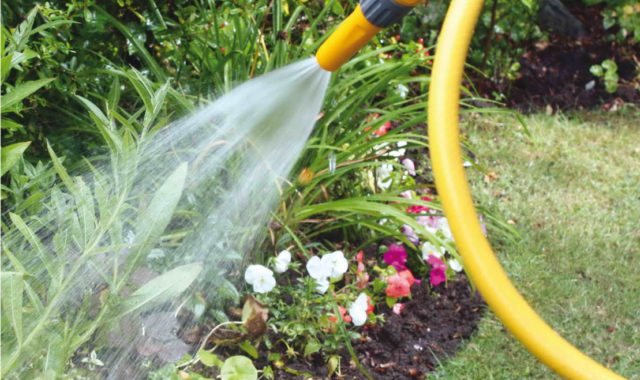

With increased activity of insects, chemical agents or an infusion of herbs are used: wormwood, celandine, chamomile. However, it should be noted that insect pests are not found in large quantities on the spirea, therefore, even in the case of their presence, the decorative effect of the bushes does not suffer.
Pruning for rejuvenation
The life span of some types of spirea is 20-25 years. One stem lives for 6-7 years. The old bush sometimes loses its attractiveness, is affected by pests, so it is betrayed by deep pruning. Such a shrub is completely cut to the ground. In the spring, dormant buds will begin to sprout near the root collar. Thus, the spirea will completely rejuvenate.
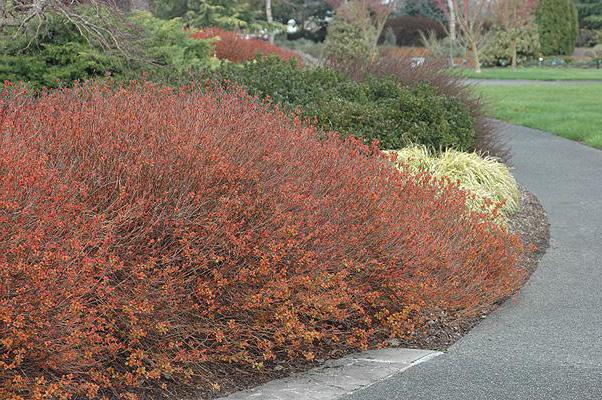

Decorative properties of shrub spirea
Spiraea Wangutta stands out among other ornamental shrubs primarily with lush flowering. Snow-white lush caps of inflorescences look like snow unexpectedly in the middle of summer against the background of dark green spirea leaves. Spirea blooms in June, early summer and lasts about a month. However, even after the end of flowering, the spirea does not outgrow to surprise you. Towards the end of summer, its leaves will begin to change their color to red shades, giving the shrub an unexpectedly different, even more elegant look, and the leaves do not fall until late autumn.
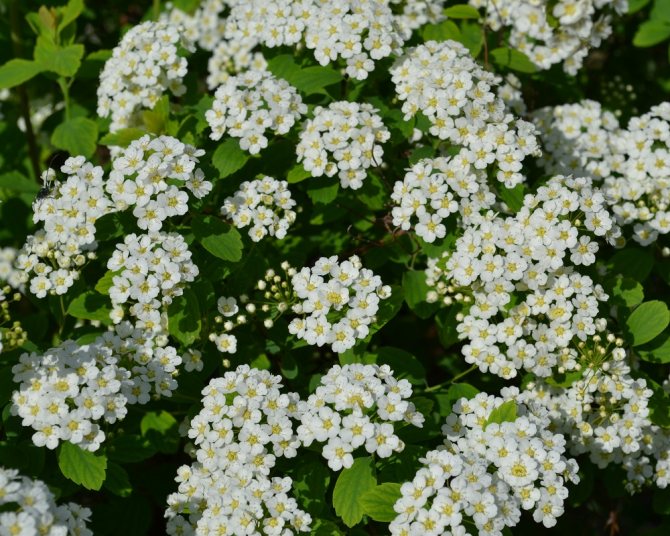

Spirea Wangutta refers to those decorative elements of the garden that will be appropriate in any composition, in any style of the garden. Spirea bushes are organically combined with many other plants, flowers and trees, but spirea bushes can also be an independent decorative element of your site, especially against the background of a lawn, along garden paths, etc.
Dense bushes of spirea can also serve as a hedge, since its branches grow almost from the ground itself, without creating empty spaces. And the height of an adult shrub just matches the height of the fence.
Spirea roots easily endure our harsh winters, and in case of damage to individual branches by frost, they can be safely removed.Literally in a month, two new shoots are formed in place of the old dried-up branches. Spirea is considered a fast-growing shrub that lends itself well to pruning.
Popular varieties
About two dozen varieties include the wangutta species. Each of them has its own size, lifespan, month and flowering frequency. Below you can find out more about three popular wangutta varieties.
Did you know? From spirea, raw materials are obtained that are used for the production of aspirin (acetylsalicylic acid).
Golden Fountain
Wangutta Gold Fontaine is popular among gardeners. They love its spreading branches and yellow-green leaves. The variety loves the sun, tolerates only light shade. It is unpretentious and frost-resistant to the soil. Golden Fountain belongs to the fast-growing and upright varieties. Sometimes the height of its stems can reach 4 m.
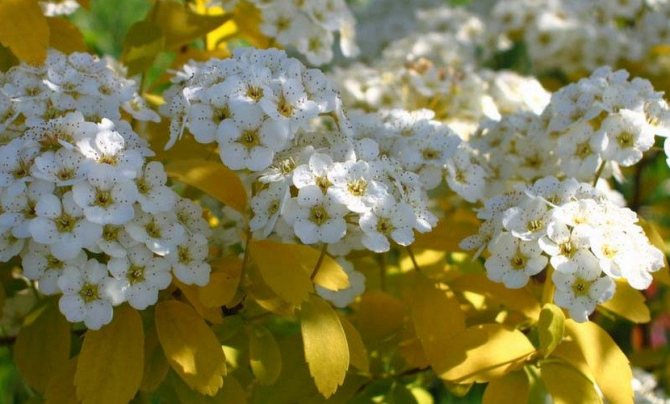

White
Vangutta White grows in the form of a spreading wide shrub, reaching a height of 2.5 m.Every year, its abundant flowering fascinates, when young shoots are completely hidden under the white caps of the inflorescences. This period falls in mid-June - early July.
Important! Wangutta is adapted to the city air. She is not afraid of smog, high gas content, pollution, so the species is suitable for planting in city parks.
Sometimes the plant can bloom again in August. It should be noted that many bees flock to the blooming spirea, and the honey turns out to be fragrant and with an unusual taste.
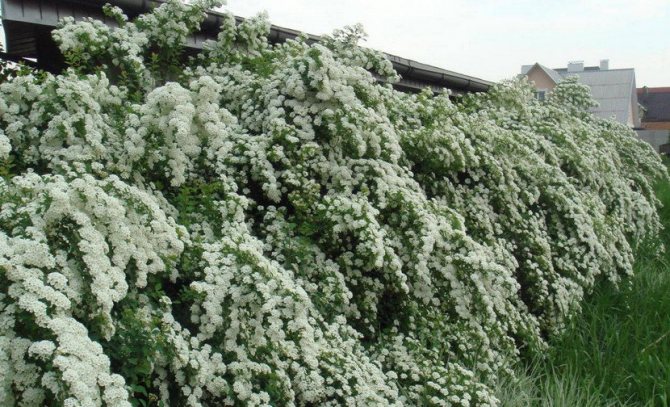

White wangutta is a fairly unpretentious culture, characterized by rapid growth. Gardeners loved this variety for its frost resistance, showiness and the ability to create permanent flowering plantings with it.
Pink Ice (Catpan)
Gardeners call Pink Ice Catpan the most attractive wangutta spirea. The shape of its crown is neat due to the small size of the bush (up to 0.5 m in height). It is distinguished by spectacular, jagged, white-pink-green leaves, similar in shape to willow foliage. The gracefully curved branches of the plant amaze with their pinkish tone.
In May-June, the shrub is covered with snow-white lush inflorescences. In order for it to please the owners with them annually, it is important to plant it in a sunny place with high soil moisture.
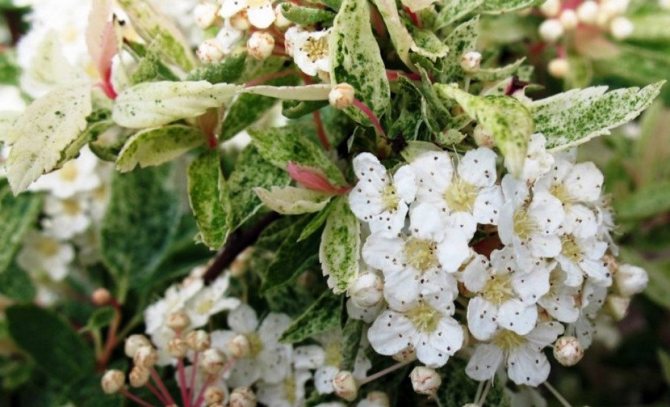

How to propagate spirea in the fall
Spirea, like many other perennial shrubs, can be propagated in the following ways:
- seeds;
- cuttings;
- layering;
- dividing the bush.
How to propagate spirea by cuttings in the fall
Spirea in the fall is quite easy to graft. Planting material for spring-flowering varieties is harvested from the beginning of summer, and summer-flowering varieties from the middle. However, it is best to propagate spirea with lignified cuttings in early autumn. To do this, he uses annual shoots, cutting them in such a way that there are at least 5 buds on each segment. To reduce the loss of moisture during evaporation, the lower leaf of the cutting is removed, and the upper one is cut in half.
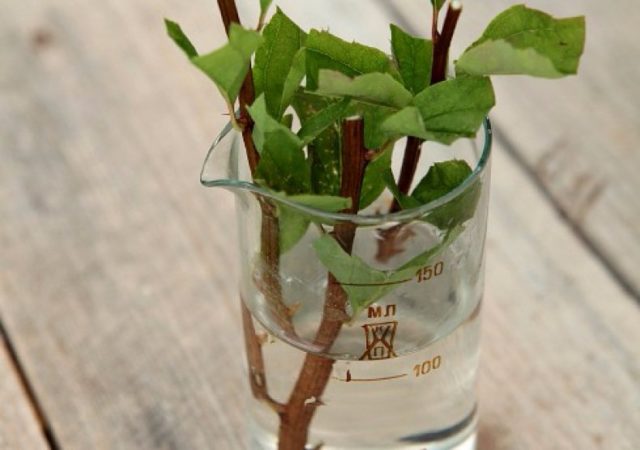

It is not necessary to use a root growth stimulator, even without it, the survival rate of cuttings reaches 70%. If the sections are processed, for example, with Kornevin, this indicator will increase to almost 100%.
It is very important to provide constant hydration. Therefore, the cuttings are placed in moistened soil, and then covered with a film on top, creating greenhouse conditions. The easiest way is to use half a plastic bottle. In this state, the cuttings remain for the winter. You just need to additionally cover the bottles on top with a layer of sawdust, dry grass or fallen leaves. In the spring, the shelter is removed, and the rooted cuttings are transplanted to a permanent place.
How to propagate spirea by dividing a bush.
Reproduction of spirea in autumn is also possible by dividing the bush. A plant over 4 years old can be used as a donor. At this time, its root system is quite developed. The mother plant is completely dug out of the ground, with the help of water from a hose, its root system is cleaned.To cut the bush into separate divisions, it is best to use a pruner.
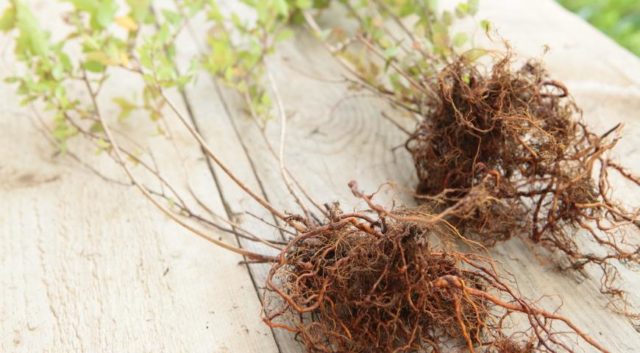

Each separated part should have several independent shoots with a full-fledged root system. Delenki are planted in prepared planting pits in the same way as usual seedlings.
When and how to cover spirea for the winter
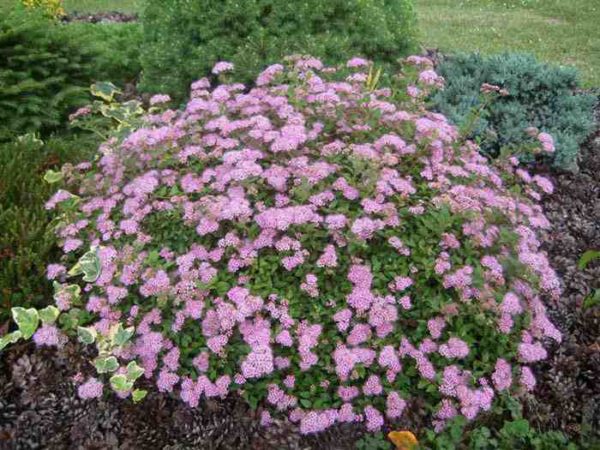

It is quite simple to protect meadowsweet from frost, while no expensive, special materials are required. In conditions of mild and snowy winters, a layer of mulch is laid up to 15 cm. Where winters are severe and snowless, the layer is increased to 25 cm and the meadowsweet is wrapped. Be sure to protect the branches of young and weakened shrubs, immunity to low temperatures in a plant manifests itself at 4 years of age. How to make sure that the covered bush does not come out:
- collect the shoots in a loose bunch, tie it with a rope or fix it with twine;
- cover the trunk circle with mulch;
- gently bend the connected branches to the ground and secure them in any convenient way;
- lay dry leaves on the stems (layer 10–30 cm) so that the wind does not carry the mulch, press it down with dry branches.
In winter, throw snow on top of the shelter, if possible. The stems can not be bent to the ground, but the bundle can be wrapped in any heat-insulating material. An air-dry shelter for wintering spirea in harsh conditions consists in organizing an impromptu greenhouse. Install the frame over the bent shoots, cover it on all sides with any waterproof material that retains heat.
Spirea care in the fall includes a number of mandatory, but very simple activities that cannot be ignored. The shrub is able to recover quickly, but if you cut it incorrectly or improperly shelter for the winter, you will most likely have to wait for a lush flowering until next year, is it really worth the risk! Be sure to study the characteristics of the varieties planted, then it will be easier for you to draw up a work plan for the fall.
Spirea lilac (Spiraea syringaeflora)
A hybrid of willow and white-flowered spirea. Low, up to 1.2 m, shrub with dense branches and lanceolate leaves. Lilac-red small flowers in wide pyramidal panicles. Blooms from June to July until the very frost. It is highly appreciated in landscape design due to its even, low growth, long-term abundant flowering and beautiful color of flowers. Particularly good for low curbs and uncut hedges. It grows well in the southern part of the forest zone and in the forest-steppe zone up to the line Kazan, Nizhny Novgorod, Moscow, Petersburg, sometimes severely freezing near the border of distribution, but without prejudice to flowering.
Care advice
Spirea is not an overly whimsical plant, but for active growth, spectacular and abundant flowering, it is necessary to provide the necessary care. It consists of watering, feeding and timely pruning, as well as preventive protection against diseases and pests.
Watering and soil care
Regular weeding, as well as surface loosening of the soil, will facilitate the access of oxygen to the roots, as well as improve the water absorption of the soil during irrigation and the absorption of fertilizers during feeding. When mulching the root zone of the spirea, there is no need for loosening and weeding. But it is important to monitor the thickness of the mulch, its layer should be at least 10 centimeters.
The plant does not tolerate stagnant water in the root area, therefore, the gardener determines the frequency of watering himself, depending on the composition of the soil. But, in general, the bushes are plentifully spilled with water 3-4 times a month, and even more often during periods of extreme heat. Care also consists in abundant spraying of the crown, which has a beneficial effect on the growth of spirea.
Fertilizing and fertilizing plants
With a planting pit of the right size, filled with a truly nutritious substrate, the first year you can not fertilize the spirea at all. In subsequent years, one treatment per season will be enough - a complex phosphorus-potassium fertilizer.And, of course, mulching the trunk circle with organic matter, in particular, rotted manure.
Pruning Spirea
For abundant, beautiful flowering, plants form a crown, and also carry out sanitary cleaning. All sick, dried, old twigs, leaves and inflorescences are periodically removed. But for successful wintering, all pruning procedures are carried out before the onset of cold weather.
The number of trimmings for decorative crown formation is 2-4 per season, depending on the growth energy. Spirea tolerates pruning well. When pruning, the gardener must remember that spirea blooms on the shoots of the second year. And it is important not to overdo it; if necessary, you need to leave 1-2 strong buds on the shoot.
Diseases and pests
First of all, it is necessary to maintain the overall health of the plants. But if agricultural technology is not followed, the spirea becomes more susceptible to diseases and pests. Damage by aphids, sawflies, gall midges is possible. For the prevention and direct control of them, spraying with a solution of insecticides is used - Aktara, Aktellik, Engio.
High humidity and acidity of the soil can provoke an outbreak of fungal diseases. To combat them, fungicides of systemic action are used - Infinito, Falcon or contact copper-containing preparations, such as Medyan Extra.
Reproduction of Spirea
The shrub is propagated by cuttings, sowing seeds and rooting of root shoots. Spirea seeds sprout poorly, it is advisable to use only fresh seed. In the conditions of a summer cottage and a garden plot, digging and rooting in pots of root shoots is preferable for reproduction.
Therefore, for the mass production of seedlings, propagation by semi-lignified cuttings is used. For rooting cuttings, the following conditions are met:
- the length of the cuttings is on average 15-20 centimeters;
- removal of leaves 3/4 of the length of the cutting;
- soaking for a day in a growth stimulant solution or dusting the cut before planting;
- the use of a rooting substrate consisting of non-acidic peat and agroperlite;
- rooting cuttings in a mini greenhouse or greenhouse;
- spraying the cuttings regularly or creating "fog".
Basic rules and scheme for autumn pruning
Novice growers do not know whether to trim spirea in the fall. Here they will find the exact answer to this question. Autumn spirea haircut begins after the plant has stopped blooming. It is important that the slices are delayed until the first frost. Some gardeners carry out this procedure at the end of September. Pruning bushes in the first year of planting is only preventive in nature: only dried and diseased branches are removed, allowing the plant to develop independently.
Decorative and rejuvenating pruning is carried out at least after a year, so as not to damage the flower buds. Too pruned spirea will not bloom so profusely.
Experienced gardeners take into account the plant variety and flowering time before clipping. Early flowering species of spirea are pruned at the end of summer. This will promote abundant flowering next year. We will provide a list of general rules that must be followed when pruning all varieties of shrubs. So, the scheme for trimming the spirea in the fall looks like this:
- The first pruning is carried out two years after planting.
- The lifespan of the branches is about 5 years, so the shearing is done to ensure the beautiful appearance of the bushes.
- Every seven years, the plants are pruned to a stump. Thus, a new bush is formed from young shoots.
- The best effect is obtained when pruning the spirea in early autumn, as soon as the plant has bloomed.
- To increase the density of the bush and reduce its size, old shoots are simply shortened.
- In order to prevent diseases, old branches and affected shoots are removed.
Distribution and habitats
Spirea Wangutta grows in the Northern Hemisphere of our planet: in Asia it grows in latitudes above the Himalayan Mountains, in Europe, the shrub is found in the forest-steppe, forest and semi-desert natural zones, as well as in the subalpine mountain belt. On the territory of America, it is distributed above Mexico.
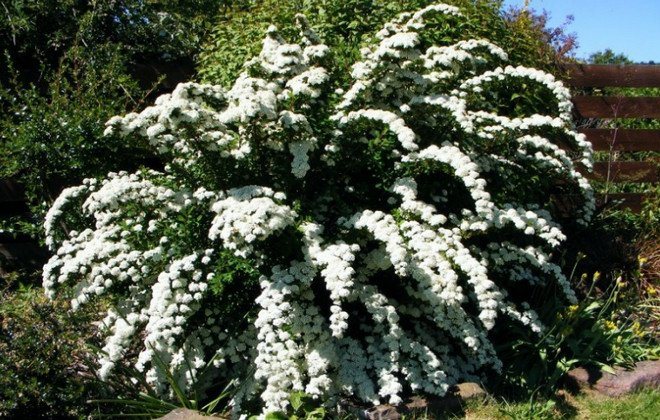

Prefers areas with sufficient sunlight, nutritious soil, tolerates cold well.
Did you know? The bark of spirea served as a raw material for the creation of acetylsalicylic acid or aspirin, known to all nowadays.
Spirea varieties
Before we move on to the description, characteristics and recommendations for caring for this plant, we suggest that you familiarize yourself with the most popular varieties of this type. He has several decorative forms, let's talk about them in a little more detail:
- Snow White. Another name for this spirea is the White Bride. A classic variety with huge snow-white inflorescences, shaped like lush umbrellas, about 60 cm in diameter. Spreading shrub, up to two meters high.
- Snow white. Spirea white, the variety was bred in Canada. The plant is compact - no more than 150 cm high, 180 cm in diameter. It has rather large white inflorescences.
- Pink Ice. Unusually beautiful and delicate spirea with large white inflorescences. Pink Ice has young growths of rich crimson color with white marble foliage. Which soon (this happens gradually) are covered with creamy spots. The variety is winter-hardy, but in severe frosts, the tips of young shoots can freeze slightly.
- Gold Fontaine. The variety was bred by Polish breeders. Spreading shrub, slowly growing, no more than 120 cm in height and up to 150 cm crown. White flowers of this variety are collected in corymbose inflorescences.
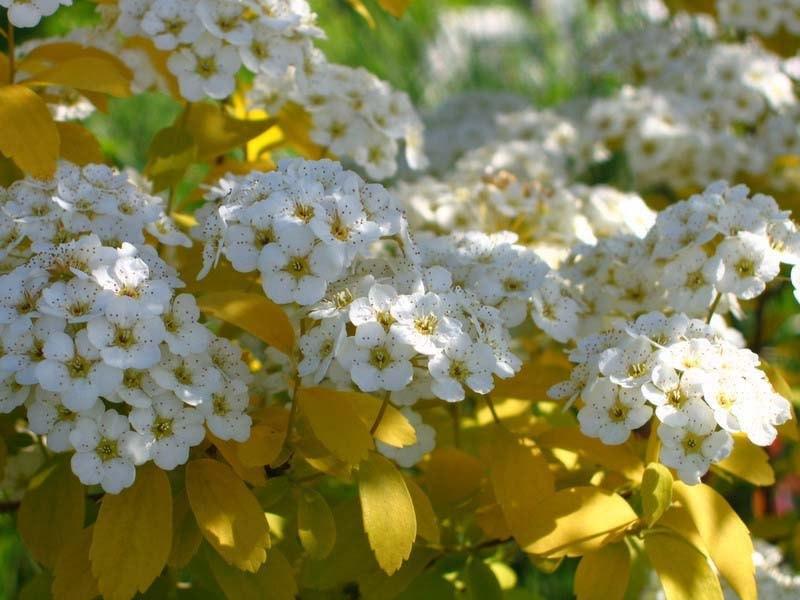

Spiraea oak-leaved (Spiraea chamaedryfolia)
Spirea oak-leaved
An upright shrub, growing up to 2 meters high, with long, ribbed shoots that curve beautifully to the ground. Leaves 3.5-4.5 cm long, ovate, bright green above, gray-gray below. Large (up to 1.5 cm) white flowers in hemispherical inflorescences. Blooms profusely for 25 days from the beginning of May. The plant is very hardy, tolerates slight shading, tolerates urban conditions well and lends itself well to cutting. In autumn, the leaves are colored yellow. The shrub is widespread in northeastern Europe, Central Asia, Siberia, and the Far East.
Top dressing and fertilization
It is necessary to form a healthy and beautiful bush even at the stage of planting a seedling in the garden. To do this, the planting hole is filled not just with earth, but with a special nutritious substrate, in which a purchased plant or a seedling obtained by cuttings should be planted. In this case, in the first year, the culture does not require feeding at all (Figure 5).


Figure 5. Nitrogen and complex fertilizers are used for feeding
In all subsequent years, the bushes are fed once a year using phosphorus-potassium fertilizers. For additional saturation of the soil with nutrients, the trunk circle is mulched with rotted manure.
Growing a bush
For all its endurance and unpretentiousness, spirea prefers planting in places well-lit by the sun. And, of course, it shows the best results when grown on loose, drained soils.
What should be the soil
Prefers fertile, loose, well-drained soil with neutral acidity. But spirea can develop successfully on different types of soils. With high soil density, a larger volume of the planting pit must be excavated. At the bottom, it is advisable to pour a layer of drainage from crushed stone, expanded clay, small pieces of brick.
Spirea willow (Spiraea salicifolia)
Spirea willow
Wildly grows in the west of North America and throughout Eurasia. Upright shrub up to 2 meters with vertically directed upward shoots of reddish-brown-yellow color, slightly faceted.The leaves are pointed, elongated, up to 10 cm, dark green above, and lighter in the lower part. Pink or white flowers are collected in narrow pyramidal or cylindrical panicles up to 20 cm long. The plant is demanding on the soil, grows better on moist, fresh soils, frost-resistant. It thickens strongly, periodically requiring cleaning. This species is very good against the background of willow, it is successfully used in group plantings.


